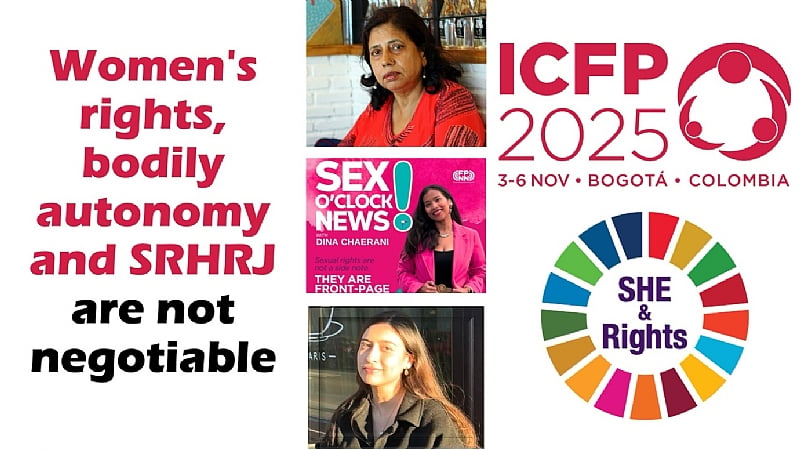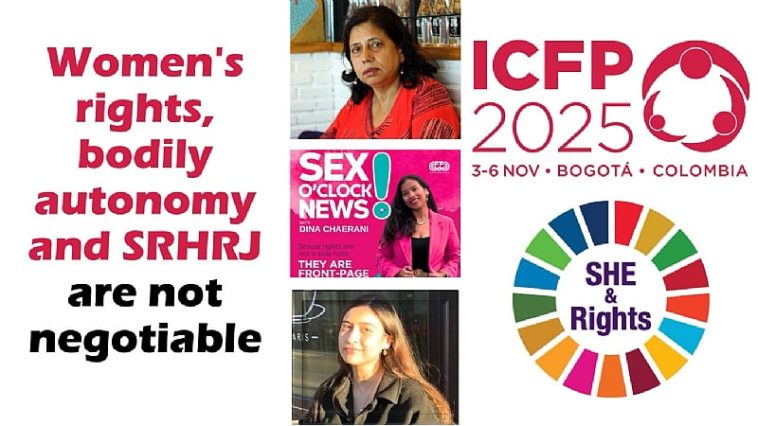
Equity Through Action: Advancing Sexual and Reproductive Health, Rights and Justice in a Shifting Global Environment
The global discussion on sexual and reproductive health, rights, and justice has been buzzing with renewed energy lately. With the upcoming International Conference on Family Planning 2025 (ICFP 2025) as the backdrop, many activists, scholars, and policymakers are taking a closer look at a tangled issue that has far-reaching implications for gender equality and public health. This opinion editorial dives into the current climate, examines the tricky parts of global policy initiatives, and offers insights into the many twists and turns on the road to meaningful change.
Changing Global Perspectives Amid Anti-Gender Push Back
Despite progress over the past decades, recent developments have exposed the confusing bits in our global journey toward ensuring sexual and reproductive health for all. Many believe that fundamental human rights—such as the right to health and gender equality—are being threatened by anti-rights and anti-gender campaigns. The narrative has become particularly loaded (with issues) when some governments twist discussions around sexuality and family planning as a way to push alternative agendas.
Key Observations from Recent UN Assemblies
The 80th United Nations General Assembly (UNGA) and the commemorative sessions around the 30th anniversary of the Beijing Declaration have revealed both significant progress and unexpected setbacks. While some nations have reaffirmed their commitment to human rights, others have attempted to downplay certain aspects. For example:
- Some countries have dismissed the constitutional or international right to abortion.
- There have been moves to reframe family planning discussions around fears of a demographic crisis.
- Civil society access and advocacy within these major forums have met with increasingly intimidating resistance.
These developments have made it clear that the path forward is full of problems—and that while progress is undeniable, the global community must continue to work through the nerve-racking challenges that crop up along the way.
A Closer Look at ICFP 2025: A Global Convergence of Ideas
ICFP 2025 is not just another conference—it is a global convergence of health experts, policymakers, youth leaders, and advocates from around the world. With a record-breaking 5,174 abstract submissions, the conference is a testament to the heightened interest and urgency surrounding sexual and reproductive health issues. The event is shaping up to be a deep dive into a mix of themes, including:
- The impact of climate on public health and SRHRJ (sexual and reproductive health, rights, and justice).
- Challenges faced by displaced populations and disrupted supply chains.
- The role of sustainable financing in making comprehensive health care accessible to all.
- Youth leadership and grassroots mobilization through 100% youth-led initiatives.
This eclectic mix of topics underlines how intertwined public health is with broader socio-political developments. In short, the conference is a landmark occasion for driving forward super important discussions and actions on sexual health, women’s rights, and family planning. It urges participants to figure a path through the many confusing bits of tangled issues that arise in today’s policy-making landscape.
Emerging Trends and the Changing Priorities in SRHRJ Conversations
The conference agenda is replete with sessions that address the nitty-gritty details of how family planning has become a nexus for larger debates about fertility, demographic changes, and normative social values. Among these topics, a few key trends stand out:
- Youth Leadership: Young people are increasingly taking the wheel in advocating for better sexual and reproductive health policies. Their contributions are not only symbolic—they are a fundamental part of reshaping the global narrative.
- Climate and Health: Discussions around the climate impact on SRHRJ have become prevalent. Organizers are keen to highlight how changing weather patterns and environmental stressors affect public health and family planning services.
- Accessibility and Digital Engagement: With sessions live-streamed across multiple platforms, ICFP 2025 is pioneering ways to make critical conversations accessible globally, ensuring that even those who cannot be present physically can take part in the dialogue.
With these trends in mind, it becomes super important to stress that while policies and discussions are essential, the true measure of success lies in how these discussions translate into concrete changes on the ground.
Intersecting Social Movements and the Fight for Gender Equality
The global push for gender equality has a long history. From the Beijing Declaration to the latest global meetings, the journey has been marked by both triumphs and setbacks. Recently, efforts to reinvigorate the UN Commission on the Status of Women (CSW) have highlighted just how loaded with issues the current political environment is. Observers note that:
- The language of gender equality is sometimes twisted to only serve a pronatalist agenda, sidelining the broader human rights context.
- Some member states resist institutional practices that bolster civil society participation, thus creating an environment that is on edge for feminist advocates.
- There is a pressing need to maintain and protect the space for civil society engagement, especially as some political leaders attempt to sideline or roll back these gains.
It is clear that while celebrating what has been achieved, we must also remain vigilant about the small distinctions and subtle details that can undermine progress if left unaddressed. Otherwise, the risk is that progressive policies will be rendered ineffective by reactionary forces that prioritize narrow interpretations of family planning and public health.
Managing Financial, Political, and Societal Challenges in SRHRJ
Addressing the tension between public policy and the myriad political and societal forces at play requires a multifaceted strategy. Here are some of the key areas that demand our focus if we are to properly push forward the agenda of sexual and reproductive health, rights, and justice:
| Area of Focus | Challenges | Strategies for Action |
|---|---|---|
| Policy Reforms | Tangled issues in legal frameworks, defensive policy changes | Advocating for robust legal commitments, aligning with international treaties |
| Economic Investment | Budget restraints, competing national priorities | Promoting sustainable financing models and public-private collaborations |
| Civil Society Participation | Nerve-racking bureaucratic barriers, institutional resistance | Empowering grassroots movements and ensuring transparent dialogue with policymakers |
| Digital and Global Outreach | Complexities in digital divide, misinformation | Enhanced online platforms for inclusive participation and clear communication strategies |
Each of these areas demands a critical look, as the strategies must be tailored to the unique twists and turns of local contexts while being aligned with global standards. By addressing these challenges head on, advocates can help ensure that SRHRJ remains a super important part of every nation’s policy agenda.
Youth Involvement in Shaping the Future of Reproductive Health
Youth have emerged as one of the most influential voices in public policy debate on sexual and reproductive matters. Far from being mere bystanders, young advocates are pushing back against the scary narratives that sometimes inform political agendas. They are actively engaged in:
- Leading pre-conference sessions that are entirely youth-driven.
- Using digital platforms to connect and share their experiences.
- Collaborating with international organizations to enhance the global dialogue on public health and human rights.
These young leaders believe that their role is crucial in steering through and figuring a path among the complicated pieces of political and social tensions. Their energy and new perspectives offer hope in a landscape that, at times, appears extremely overwhelming. Their grassroots initiatives ensure that the conversation remains fresh and inclusive—an approach that is both refreshing and needed in the current atmosphere.
Digital Innovations and Virtual Engagement: Bridging the Accessibility Gap
One of the standout features of ICFP 2025 is its commitment to digital inclusivity. Recognizing that not everyone can attend in person, organizers have set up a structure that allows for multiple ways to get into the action:
- Live Streams: Major sessions are being broadcast live on platforms such as YouTube, enabling a global audience to tune in.
- Recorded Sessions: An online library of recorded sessions is planned, so those who miss a live presentation can catch up later at their convenience.
- Virtual Scientific Streams: For those desiring a deeper look into the technical aspects of SRHRJ, there will be paid virtual scientific streams that offer advanced insights.
These efforts ensure that the conversation on sexual and reproductive health is not confined to a single venue. Instead, they expand the potential for informed engagement to people from various backgrounds, ensuring that no one is left behind. In a world where connectivity defines progress, such digital initiatives are not just essential—they are a must-have in modern advocacy.
Decoding the Impact of Political Push Back on Health Rights Advocacy
Recent sessions at the UN High Level Meetings have revealed a worrying trend where some political leaders, particularly from influential nations, are attempting to reframe discussions about family planning and reproductive rights. The language used often emphasizes concerns over fertility rates rather than addressing the underlying issues of bodily autonomy and social justice. This approach can be misleading and dangerous for several reasons:
- The conversation is shifted away from a rights-based approach to one that is purely demographic in focus.
- Such framing reduces complex public health matters into oversimplified talking points that fail to capture the subtle details of reproductive justice.
- It places undue pressure on women by framing their health and rights as tools in managing national demographics.
Public health advocates caution that while governments have made certain commitments on paper, putting those commitments into practice involves navigating a series of tricky parts. It is essential for the global community to remain vigilant and insist that women’s rights and bodily autonomy remain non-negotiable elements of any family planning or health initiative.
Collaborative Networks and Civil Society: Strengthening the Advocacy Framework
A critical aspect of pushing for meaningful change in sexual and reproductive health lies in the collaborative network formed by international organizations, grassroots movements, and independent advocates. Groups such as the UN Commission on the Status of Women, international feminist alliances, and regional coalitions have been working together to:
- Secure robust normative frameworks for gender equality.
- Ensure that civil society is front and center in monitoring and holding governments accountable.
- Create platforms for transparent dialogue between policymakers, experts, and community stakeholders.
This collaborative effort makes it easier for advocates to separate the signal from the noise in a sea of conflicting information and political rhetoric. It also ensures that there is a consistent pushback against any attempts to roll back hard-won rights. In a climate oriented around political maneuvering, these alliances serve as a reminder that transparency, cooperation, and public engagement are key to overcoming the tangled issues posed by discriminatory practices.
Challenges Ahead: Overcoming Obstacles in Policy and Practice
While events like ICFP 2025 and various UN assemblies are bright spots in the movement for sexual and reproductive rights, the road ahead is still filled with intimidating challenges. Policy changes, by nature, come with their share of obstacles. Here are some of the nerve-racking issues that continue to surface:
- Policy Lag: There is often a significant delay between the promises made in international forums and their implementation at the national level.
- Resource Limitations: Financial constraints and competing priorities in national budgets can rob health policies of the resources they need.
- Political Resistance: Certain governments or political factions resort to twisting language and pushing back against reforms, often citing cultural or demographic concerns.
- Societal Stigma: Deep-seated traditional beliefs and social stigma continue to hinder efforts to modernize family planning and health education.
Overcoming these obstacles will require not just resilient policy frameworks but also a concerted effort from civil society to mobilize, advocate, and ensure accountability. Everyone involved in the conversation needs to find their way through these challenging bits while remaining anchored to the core principles of human rights and dignity.
Strategies for Building a Resilient Future in SRHRJ
What are the strategies that can help steer the conversation in the right direction and truly make a difference? Based on the current landscape and emerging trends, the following steps seem crucial:
- Unified Advocacy: Build and nurture alliances across different sectors—including government bodies, civil society, youth networks, and international organizations—to ensure a coordinated response to policy setbacks.
- Data-Driven Policy Making: Use research and real-world data to drive conversations around sexual and reproductive rights. Evidence-based advocacy can help counteract misleading political rhetoric and clarify the fine points of public health challenges.
- Enhanced Digital Outreach: Continue building robust virtual platforms that allow for real-time engagement and the dissemination of scientific research. The more accessible the conversation, the better the global community can respond.
- Grassroots Mobilization: Empower local communities to take charge of their health narratives. Grassroots movements provide the driving force behind many policy successes and offer a necessary counterbalance to top-down decision-making processes.
- Policy Transparency and Accountability: Establish clear mechanisms for tracking government commitments and ensure that any rollback is met with rapid and effective public scrutiny. Constant monitoring and pressure can help enforce the spirit of international agreements.
Empowering Communities: Real Stories and Local Initiatives
A close examination of local initiatives around the world reveals that many communities are already taking proactive steps to secure sexual and reproductive health rights. Whether through youth-led campaigns in developing nations or advocacy by seasoned civil society organizations in more developed regions, there is a common thread: people are demanding that their rights be respected and that they are given the tools required for a healthy life.
Consider the following real examples:
- A group of young activists in Latin America has started a digital campaign to counter misinformation about contraception, emphasizing the little details behind safe practices.
- In parts of Asia, local NGOs are organizing community health workshops that demystify the complicated pieces of modern family planning discussions, ensuring that even traditionally conservative communities understand the importance of informed choices.
- In Africa, collaborations between local health authorities and international organizations have led to successful outreach programs that integrate digital tools and on-the-ground support, tailoring information to the complicated twists and turns faced by rural populations.
These community-driven stories are encouraging and underscore that change is possible when grassroot initiatives combine with international advocacy. It is crucial that these success stories be amplified as they provide not only hope but also a roadmap for tackling many of the issues that continue to plague larger political debates.
Lessons Learned from Past Global Conferences and Future Implications
Looking back at major international conferences such as the 1995 Beijing Declaration and the subsequent Global Conferences on Women, we notice that real progress in gender equality and public health often comes in fits and starts. Here are a few lessons that stand out:
- Progress is rarely linear. There are setbacks and unexpected challenges that demand resilience and adaptability.
- The involvement of diverse voices is key. Whether it’s the input from civil society or the fresh perspectives of youth, inclusivity drives sustainable change.
- International commitments need domestic follow-up. Without a strong bridge between global declarations and local implementations, even the most well-intentioned policies can remain mere statements.
- Digital outreach is invaluable. In the modern age, the internet serves as a powerful platform for dialogue, advocacy, and accountability, making it easier than ever to mobilize public opinion.
These lessons highlight that while strategic frameworks such as ICFP 2025 are critical, the true measure of success will be seen in how countries integrate these policies into everyday realities. The challenge is to continuously find your way through the complicated pieces and create an environment where every citizen’s right to health is upheld without compromise.
Advancing a Shared Vision for Global Health and Human Rights
At its core, the debate around sexual and reproductive health, rights, and justice is not just about policy—it is about people. It is about ensuring that every individual, regardless of their background or where they live, has the chance to lead a healthy, dignified, and empowered life. Here are some of the super important components of this vision:
- Human Dignity: Every policy and initiative must be grounded in the principle that human rights are fundamental and non-negotiable.
- Inclusiveness: A shared vision is only as strong as its capacity to welcome diverse perspectives—ensuring that even those on the margins have a seat at the table.
- Sustainable Development: By integrating economic, environmental, and social dimensions, policies can be both impactful and enduring.
- Global Accountability: It is key to continuously monitor progress at both the international and local levels, ensuring commitments lead to real change.
Such initiatives remind us that while the journey towards gender equality and health justice is undoubtedly filled with intimidating twists, every step forward is a testament to the resilience of the human spirit and the strength of collective action.
Final Reflections: A Call to Action for a More Equitable Future
In conclusion, events like ICFP 2025 should be seen as more than a series of sessions and debates—they are rallying points that unite a wide array of voices all pushing for a better, more just world. The discussion is far from over, and while the road ahead is loaded (with issues) and at times appears quite overwhelming, the progress seen thus far provides renewals of hope and energy for further action.
As we reflect on the progress made since the days of the Beijing Declaration, it becomes clear that while some governments may seek to push back on gender equality and the right to health, the spirit of advocacy remains unyielding. With youth leading the charge, communities working from the ground up, and international collaborations forming stronger networks, there is every reason to believe that the upcoming years will witness transformative changes.
Let us use the platform provided by ICFP 2025 and similar initiatives as a springboard to dive in, uncover the subtle parts of these formidable challenges, and convert global commitments into tangible, lasting change. Whether it is through enhanced digital engagement, unwavering advocacy for policy transparency, or grassroots mobilization, it is essential that everyone involved does their part to steer through these complicated pieces and ensure that rights are not negotiated down or sidelined under any circumstances.
Key Takeaways and Recommendations
To wrap up, here are some bullet points summarizing the major points discussed in this editorial:
- Global meetings such as ICFP 2025 are critical vehicles for re-energizing the conversation on sexual and reproductive health, rights, and justice.
- Youth involvement and digital outreach are reshaping how advocacy is conducted and ensuring inclusivity in global discussions.
- Political pushback and misrepresentations are common, thus it is crucial to remain vigilant and keep women’s rights non-negotiable.
- Collaborative networks between civil society, international organizations, and ground-level activists are key to addressing the tricky parts of modern policy challenges.
- The path towards equitable health for all involves overcoming nerve-racking obstacles and transforming commitments into practical, measurable outcomes.
It is clear that while the road ahead may be filled with intimidating challenges and tangled issues, the collective effort of global advocates offers a bright future for sexual and reproductive health. This is a call to action for policymakers, community leaders, and every individual to actively engage and ensure that the rights of every person are upheld.
Moving Forward with Courage and Commitment
The debate around sexual and reproductive health is not merely academic—it affects real lives. As nations work to reform outdated policies and tackle the overwhelming challenges of today, the experiences shared at platforms like ICFP 2025 highlight a common truth: Every step forward is a victory for all of us. Despite the nerve-racking uncertainties ahead, maintaining a shared vision of equality, dignity, and comprehensive health remains our most promising way to shape a fairer and more resilient future.
Let us all commit to this cause by staying engaged, informed, and dedicated to making sure that the twists and turns of the journey only serve to strengthen our resolve. The future of sexual and reproductive health, rights, and justice depends on our collective action today, and every voice counts in this crucial conversation.
In Summary
The discussion on sexual and reproductive health is multifaceted—filled with both promise and challenges. With ICFP 2025 acting as a catalyst, the global community now has a renewed opportunity to tackle the confusing bits and hidden complexities that impede progress. By harnessing the energy of youth, embracing digital innovations, and building resilient, inclusive networks, we have the chance to sculpt policies that honor human rights and secure a healthier future for all.
As we continue to dive in and uncover both the obvious and subtle details hidden within these debates, let’s remind ourselves to stay committed, to work together, and to use every available resource so that the right to health and equality is not just an aspiration, but a reality for everyone.
Originally Post From https://www.modernghana.com/news/1441739/amidst-anti-gender-push-hope-pins-on-icfp-2025.html
Read more about this topic at
Advancing Solutions for Reproductive Justice
Advancing Reproductive Justice for All


